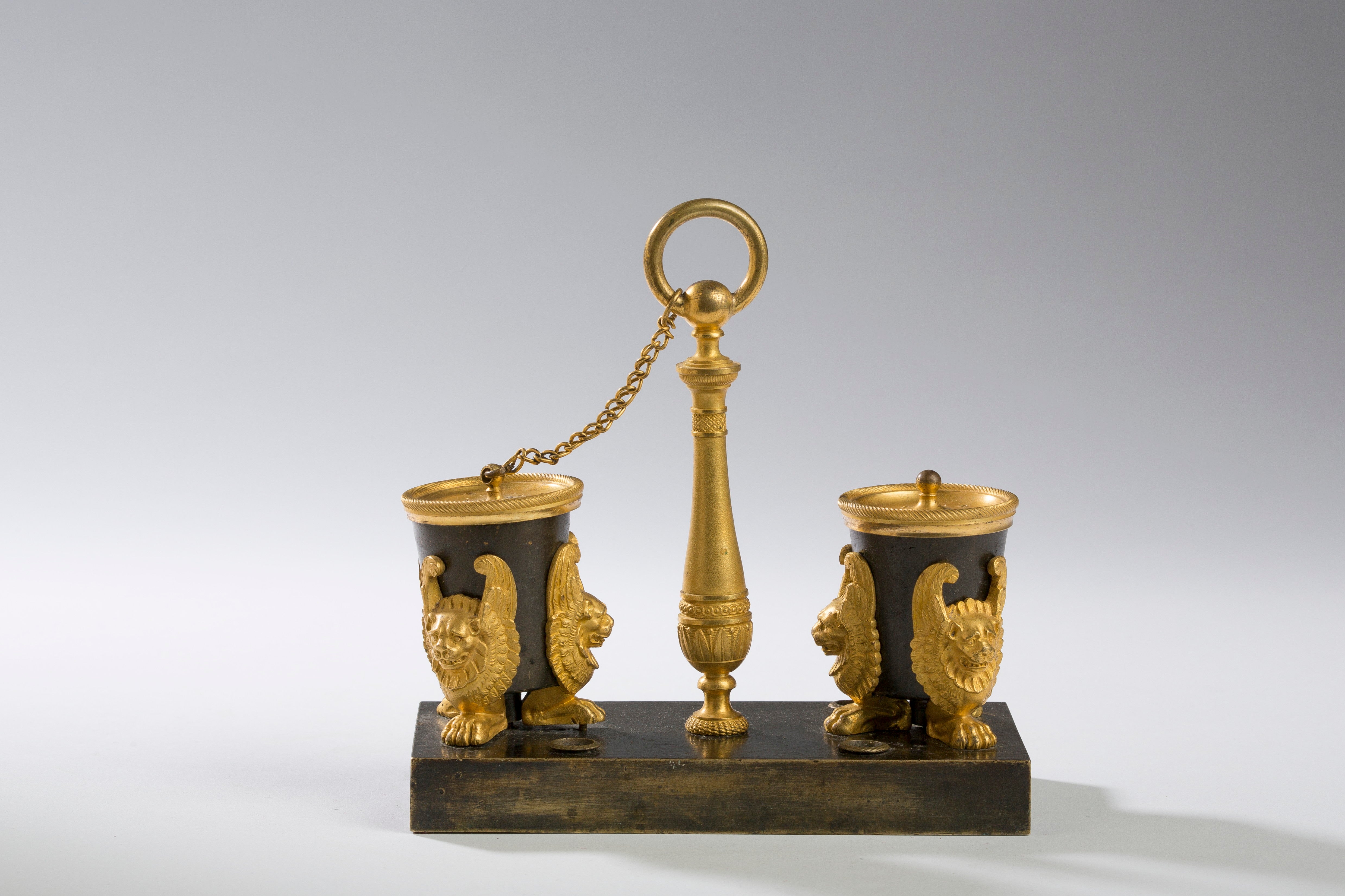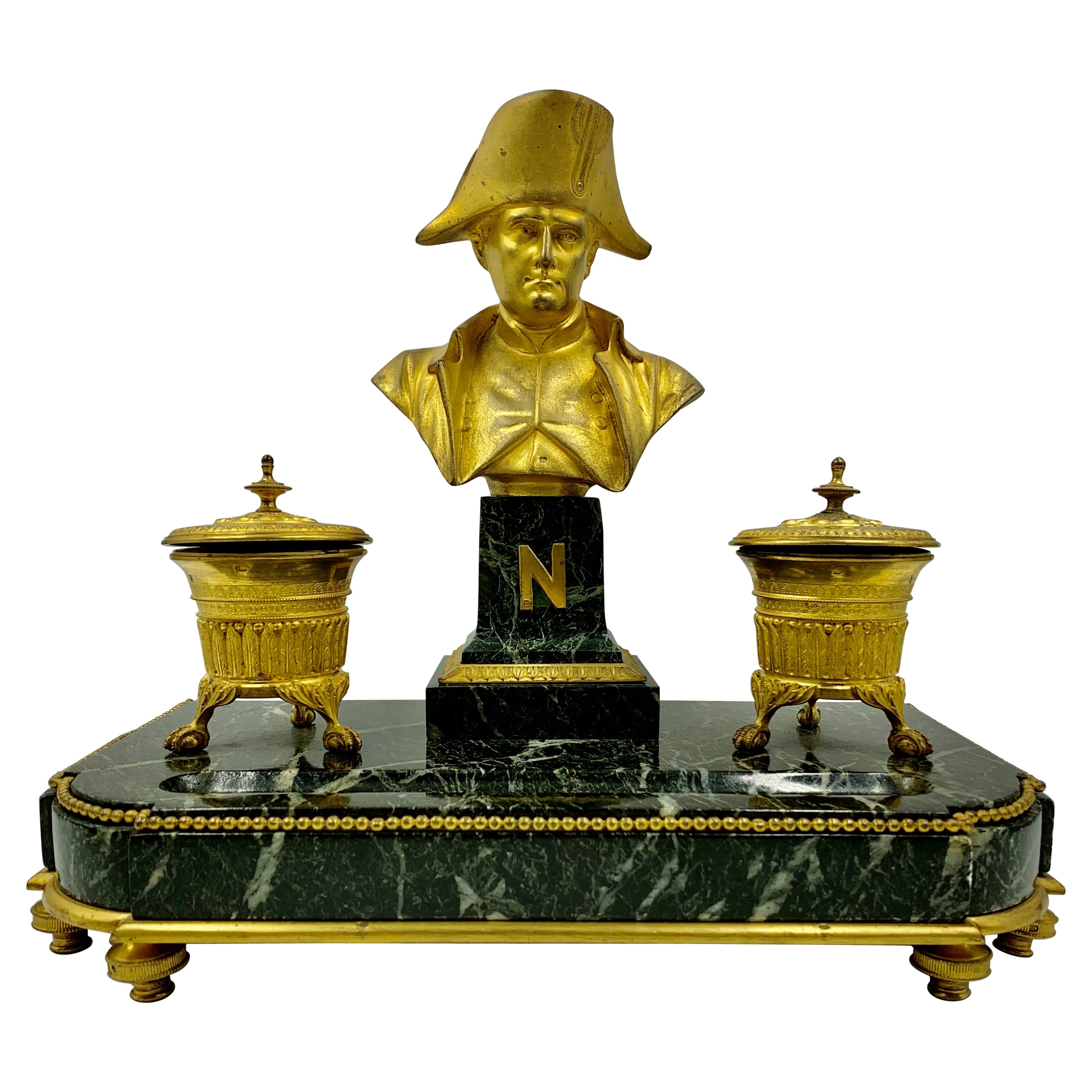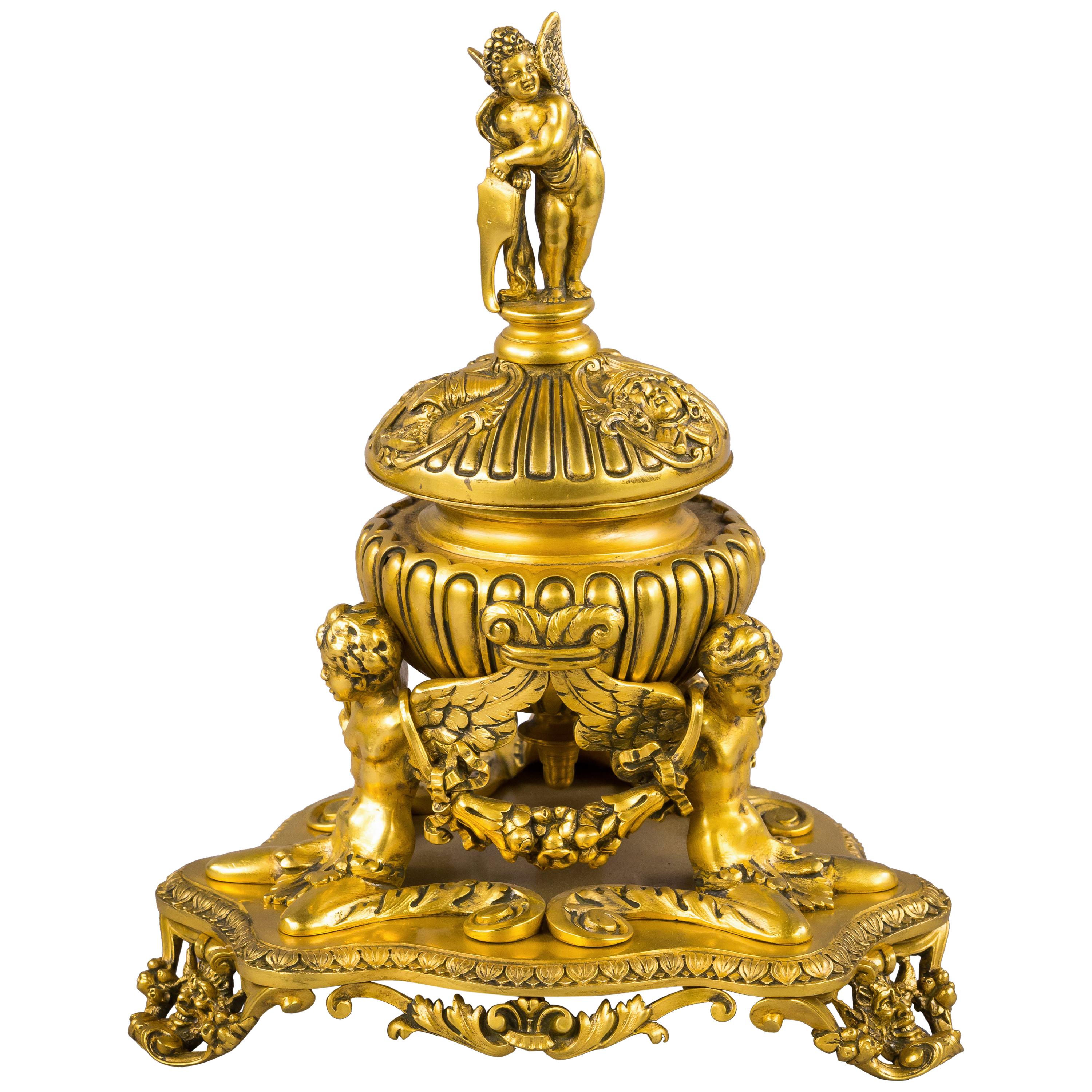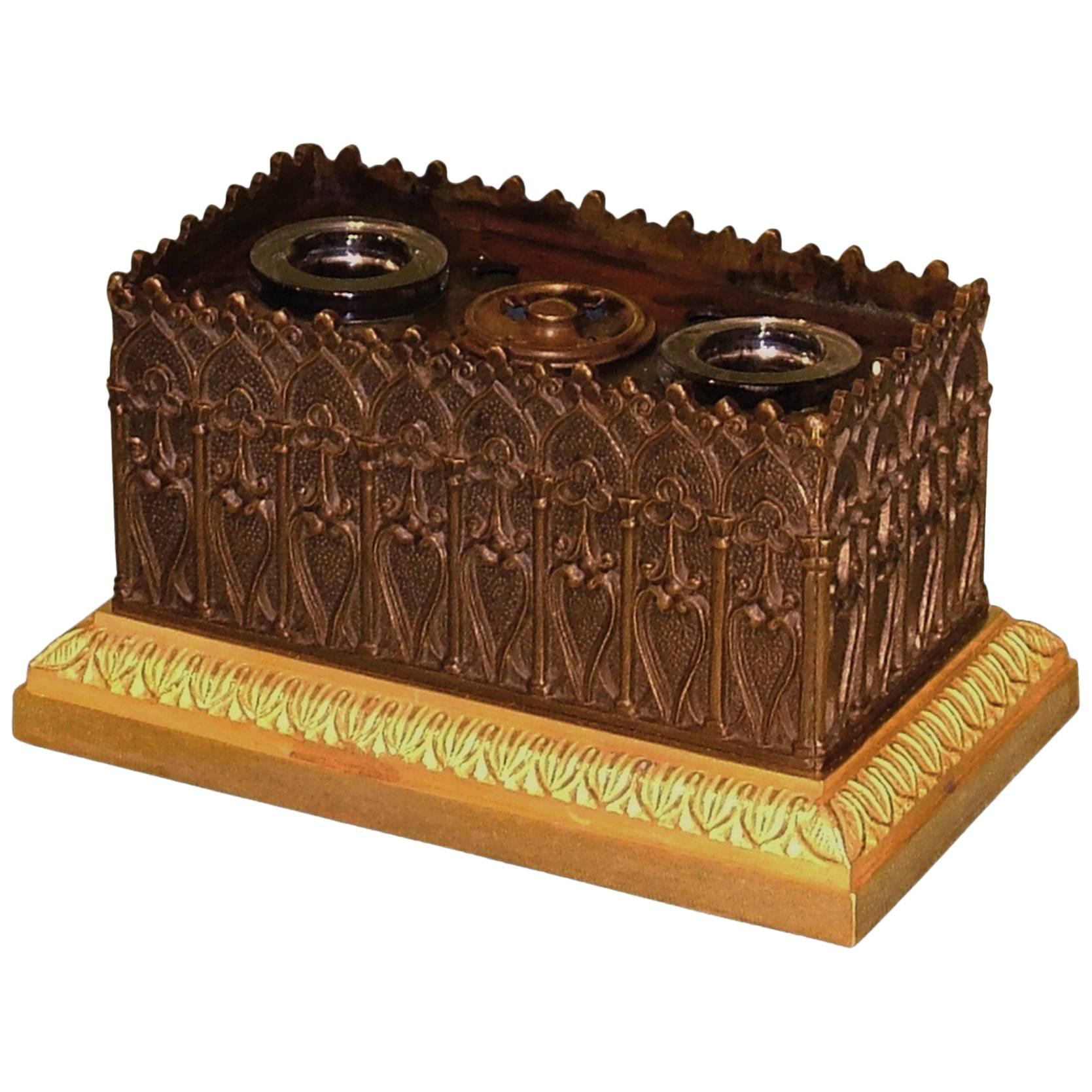Items Similar to Silvered Brass and Gilt Encrier with Shepherdess and Monogram, circa 1900
Want more images or videos?
Request additional images or videos from the seller
1 of 18
Silvered Brass and Gilt Encrier with Shepherdess and Monogram, circa 1900
About the Item
This charming encrier, or inkwell, is made from silvered brass and gilt bronze. A central gilded figure holding a shepherd’s crook stands on top of a hexagonal pedestal with supporting brackets made of curled leaves. Flanking the vivid shepherdess and her dog (or sheep) are two cut circles that house the silver topped crystal inkwells. A row of small palmettes encircle each inkwell and extends in front of the shepherdess.
The recessed center tray, where the pens would lay when not in use, is adorned with a raised molding that mirrors the unique shape of the tray. Etched floral and foliate elements run along the inside of the molding. The tray sits on two distinct sets of feet. The back feet are angular plinths adorned with curled leaves. The front feet are monopodial espagnolettes. Not to be confused with the locking mechanism of the same name, an espagnolette is an ornamentation that depicts the bust of a woman. In this case, the bust is a sphinx, which is a mythical creature with the upper body of a woman and the lower body of a lion, as represented by the single paw foot. Between the sphinxes is a heart-shaped cartouche surrounded by curled leaves and a water leaf. In the center of the heart is a stylish monogram with the two letters "J" and "D".
Our unique circa 1900 silvered brass and gilt encrier would make a fantastic addition to any office or library.
- Dimensions:Height: 9.5 in (24.13 cm)Width: 18.625 in (47.31 cm)Depth: 11.375 in (28.9 cm)
- Style:Art Nouveau (Of the Period)
- Materials and Techniques:
- Place of Origin:
- Period:1900-1909
- Date of Manufacture:circa 1900
- Condition:Replacements made: One crystal inkwell has been replaced. Wear consistent with age and use. Minor fading. Wear commensurate to age and use with minor scratches to brass. Buildup to gilding. One inkwell has been replaced.
- Seller Location:Dallas, TX
- Reference Number:
About the Seller
5.0
Platinum Seller
These expertly vetted sellers are 1stDibs' most experienced sellers and are rated highest by our customers.
Established in 1983
1stDibs seller since 2011
738 sales on 1stDibs
Typical response time: <1 hour
- ShippingRetrieving quote...Ships From: Dallas, TX
- Return PolicyA return for this item may be initiated within 2 days of delivery.
More From This SellerView All
- Large Antique French Marble and Bronze Inkwell, circa 1880Located in Dallas, TXThis is a stunning, large, antique French marble and gilt bronze double inkwell. The inkwells’ lids are hinged to the wells and have motifs of swirling leaves with berries culminatin...Category
Antique 1870s French Louis XIV Inkwells
MaterialsMarble, Bronze
- Napoleon III Gilt Bronze Inkwell from France, C. 1840Located in Dallas, TXThis piece of nineteenth-century French elegance is sure to be the envy of any collector. The Napoleon III gilt bronze inkwell is a prized find, crafted in circa 1840 France with int...Category
Antique 1840s French Napoleon III Inkwells
MaterialsMetal, Bronze
- Unusual Carved Walnut Wood Inkwell from France, Circa 1880Located in Dallas, TXHand-carved from walnut in France, circa 1880, this unusual inkwell features foliate and floral motifs. A flip-top lid adorned with a pair of bas relief flowers tops the central pen ...Category
Antique 1880s French Inkwells
MaterialsWalnut
- Antique French Ecritoire Desk in Burled Elm, circa 1830Located in Dallas, TXThis large and stylish 19th century French ecritoire is made of a beautiful burl elm veneer and ebonized wood with an intricate applique design to the top. An ecritoire is typical...Category
Antique Early 19th Century French Desk Sets
MaterialsMetal, Brass
- Silvered Bronze Table Jardiniere from France, circa 1900Located in Dallas, TXInspired by the movement of plants and flowers, Art Nouveau is a decorative style associated with art and architecture during the late 19th early 20th centuries. Sometime after 1900, the undulating lines associated with Art Nouveau began to disappear and were replaced by geometrical shapes. That places the crafting of this silvered bronze table...Category
Antique Early 1900s French Art Nouveau Planters, Cachepots and Jardinières
MaterialsBronze
- Circa 1900 Oval Gilt Bronze Table Mirror from ItalyLocated in Dallas, TXDating to circa 1900, this Italian table mirror features a small oval mirror surrounded by an intricate and pierced gilt bronze frame. A subtle molding of rais-de-cœur immediately en...Category
Antique Early 1900s Italian Table Mirrors
MaterialsMetal, Bronze
You May Also Like
- Important Exhibition Encrier by François Linke and Léon Messagé, circa 1900By François LinkeLocated in Brighton, West SussexA very rare and important exhibition encrier by François Linke and Léon Messagé. French, circa 1900. Index number 709. Signed to the edge 'F. Linke'. This exceptional and ambitious encrier is modelled as two putti, each holding a standard and sitting on the water's edge, the two inkwells with hinged spirally-fluted covers with glass liners. This important inkwell is based on Léon Messagé's celebrated sculptural group 'La Source' and was originally intended by Linke to form part of his spectacular Stand at the 1900 Paris Exposition Universelle. Like seven or eight other pieces originally intended for inclusion on the Stand, it would seem the encrier was a casualty of both Linke's over-ambitious production schedule and the financial burden that the manufacture of such ornate and high quality work imposed. It was eventually shown on the Stand in September after the gilding was finished by Picard at a cost of 90 French francs. The costs of the model were very high: some 2024 francs (of which Message's combined fee was 1158 francs 40 centimes), underlining the originality and complexity. The 1900 Exposition example was sold, along with three important pieces of furniture from the Stand (the Grand bureau and associated armchair, and the Bahut Louis XV Mars et Vénus), to the South African banker and diamond merchant Solomon Joel. A further six encriers were produced up until 1925. Object Literature: Payne, Christopher. François Linke, 1855-1946, The Belle Époque of French Furniture, p. 90, pl. 97; p. 149, pl. 157; p. 150; pp. 182-183, pls 197 & 198 as exhibited at the Liege exhibition in 1905 & p. 480 for the original notes in Linke's Blue daybook of the late 1890s. François Linke (1855 - 1946) was the most important Parisian cabinet maker of the late nineteenth and early twentieth centuries, and possibly the most sought after cabinet maker of his period. He was born in 1855 in the small village of Pankraz, in what is now the Czech Republic. Records show that Linke served an apprenticeship with the master cabinetmaker Neumann, then in 1875 at the age of 20 he arrived in Paris where he lived until he died in 1946. It is known that the fledgling Linke workshops were active in Paris in the Faubourg St. Antoine as early as 1881, and during this time he supplied furniture for other more established makers such as Jansen and Krieger. The quality of Linke's craftsmanship was unsurpassed by any of his contemporaries and reached its peak with his spectacular Stand at the Paris Exposition Universelle in 1900, where his Grand Bureau took the Gold Medal. He gambled his fortune and reputation on this Stand, exhibiting several breathtaking items of furniture with sculptural mounts of the most exceptional quality and proportion. His gamble worked and his reputation was established to such an extent that Linke continued to be the pre-eminent furniture house in Paris until the Second World War. As the Art Journal reported in 1900 on Linke's Stand: 'The work of M. Linke ... was an example of what can be done by seeking inspiration amongst the Classic examples of Louis XV and XVI without in any great sense copying these great works. M. Linke's work was original in the true sense of the word, and as such commended itself to the intelligent seeker after the really artistic things of the Exhibition. Wonderful talent was employed in producing the magnificent pieces of furniture displayed....' The formation of Linke's distinctive style was made possible by his collaboration with the sculptor Léon Messagé. Together Linke and Messagé designed furniture for Linke's 1900 exhibition Stand, with exuberant allegorical figures cast in high relief, that exemplified Linke's ability to seamlessly merge the different mediums of wood carving, bronze and marquetry into a dynamic unified whole. Today Linke is best known for the exceptionally high quality of his work, as well as his individualism and inventiveness. All of his work has the finest, most lavish mounts, very often applied to comparatively simple carcasses. The technical brilliance of his work and the artistic change that it represented were never to be repeated. Bibliography: Payne, Christopher. François Linke, (1855 - 1946), The Belle Époque of French Furniture, Antique Collectors' Club, (Woodbridge, UK), 2003. Meyer, Jonathan. Great Exhibitions - London, New York, Paris, Philadelphia, 1851-1900, Antique Collectors' Club, (Woodbridge, UK), 2006; pp. 298 - 300. LeDoux - Lebard, Denise. Les Ébénistes du XIXe siècle, Les Editions de l'Amateur, (Paris), 1984; pp. 439-43. Revue Artistique & Industrielle, (Paris), July-August 1900. Coral Thomsen, D. (ed), The Paris Exhibition 1900, The Art Journal, 1901; p.341. Léon Messagé (1842-1901) had a brilliant, but short lived career. He is best known for his incredible sculptural collaboration with François Linke for the 1900 Paris Exposition Universelle. A gifted sculptor, Messagé was also responsible for much of the design and creative work for Roux et Brunet and Joseph-Emmanuel Zwiener. Messagé enjoyed great success as a designer/sculptor before his collaboration with Linke. Indeed he was mentioned as a Gold Medal winner at the 1889 International Exhibition and was especially praised for his work on a cabinet by Zwiener. He came into contact with Linke in 1885 and it appears from then on Linke employed him on a regular basis. Messagé was primarily influenced by Rococo ornament but he strove to re-interpret it. He did not produce slavish copies, and his original approach can be appreciated in Linke's celebrated Grande Bibliothèque and Grand Bureau exhibited at the 1900 Paris Exposition Universelle. A number of drawings by Messagé are recorded and after his success at the exhibition of 1889 he was encouraged to publish his designs. 'Cahier...Category
Antique Late 19th Century French Louis XV Inkwells
MaterialsBronze
- Empire Gilt and Patinated Bronze Inkstand 'Encrier'Located in Kittery Point, METhe rectangular base mounted with a round lidded ink pot with a porcelain container and a sand pot, each raised on winged lion feet, centered by a ...Category
Antique 19th Century French Empire Inkwells
MaterialsBronze
- Antique Gilt Bronze Letter Opener with Figure of a Dog, circa 1900Located in Petaluma, CAWe bought a nice collection of letter openers and a few were very special, this is one of them. A nice presentation of an adorable dog moving along on the handle portion of the lette...Category
Early 20th Century French Art Nouveau Letter Openers
MaterialsBronze
- Napoleon I Empire Encrier, Gilt Bronze and Verde Antico, Signed Basil, 1830Located in New York, NYImpressive gilt bronze and Verde Antico marble inkstand centered by a bust of Napoleon I, the sculpture signed on back Basil and dated 1830, with two inkwells flanking. Beautifully...Category
Antique 19th Century French Empire Inkwells
MaterialsMarble, Bronze
- Gilt Bronze Figural Inkwell, E.F. Caldwell and Co., circa 1900Located in New York, NYGilt bronze figural inkwell, E.F. Caldwell and Co., circa 1900.Category
Antique Early 1900s American Inkwells
MaterialsBronze
- Regency period bronze and ormolu gothic encrierLocated in London, GBAn early 19th century Regency period bronze and ormolu encrier, having inkwells and star pierced sander, contained in Gothic fret body, supported on leaf decorated plinth base.Category
Antique Early 19th Century English Regency Inkwells
MaterialsOrmolu, Bronze
Recently Viewed
View AllMore Ways To Browse
Silvered Brass
Antique Desk Circa 1900
Lion 1900
Library 1900
Woman Circa 1900
Antique Brass Pen
Silver And Gold Desk
Brass Mirrored Tray
Antique Mirror Desk
Antique Desk Mirror
Antique Mirrored Desk
Antique Desk And Mirror
Mirror With Lions
Gilt Mirror Cartouche
Brass Mirror 1900
Antique Silver Inkwells
Silver Inkwells Antique
Brass Desk Tray





